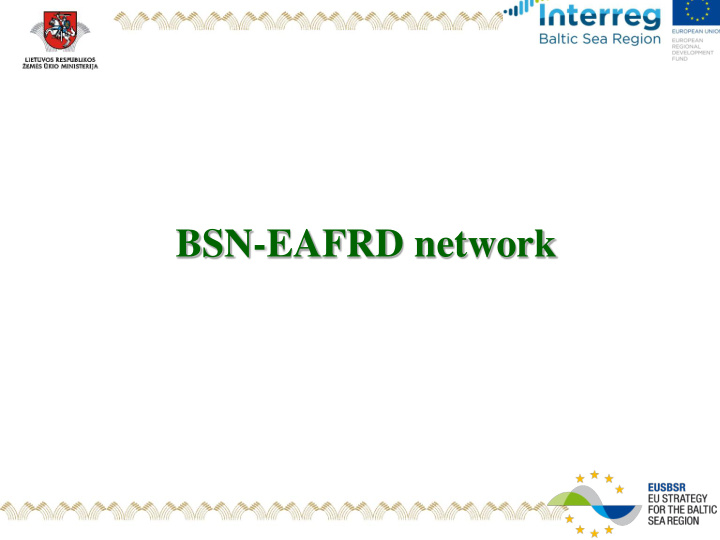



BSN-EAFRD network
Why do we need Baltic Sea Network for EAFRD? • Common strategy for the region (EUSBSR) and common goals • An identity of Baltic Sea Region • MA’s practical co-operation, information exchange, harmonized implementation • Same problems, same kind of weather conditions (in agriculture) • Rural Development policy recommendations
Background Legal basis ۩ EUSBSR PA Bioeconomy Action 5: Enhance the combined effects of the RDPs ۩ EC recommendations to align existing funds into macro regional strategies ۩ As a result of Baltic Leadership Programme funded by Swedish Institute Aim • to facilitate and strengthen transnational cooperation in the EAFRD in order to invigorate the link between the EAFRD and the EUSBSR
Network members – RDP officials • Estonia • Finland • Germany • Latvia • Lithuania • Poland • Sweden
Objectives Short-term: Long-term: • Continue cooperation • Exhange good in BSR practices • Establish common • Recommendations for understanding strengthening the legal basis for TNC in RDPs • Facilitate and post-2020 strengthen TNC in RDP projects • Set of the common goals for post- 2020 RDP‘s
Way of activities LT Ministry of Agriculture – network coordinator • Way of communication – Meetings (at least twice a year by using existing platforms such as EUSBSR Strategy Forum) – Internet (via e-mails, videoconferences, etc.) • Cooperation – Other relevant networks and projects (e.g. Nordic- Baltic Network meeting) – Relevant stakeholders • Organization – Conferences – Partner search events
Funding • National Rural Networks • RDP Technical Assistance • Interreg (Baltic Sea Region) • CBSs Council of Baltic Sea States • Nordic Council of Ministers • Swedish Institute (Alumni, Seed Money)
KEY POINTS IN RDP • Key points of bioeconomy: – Renewable natural resources to produce food, energy, products and services; – Prevention of biodiversity loss; – Economic growth and job creation (in the regions and rural areas) in line with the principles of sustainable development. • Key points of Policy: – Coherence with EU regulations, macro regional strategy and National Bioeconomy Strategies; – Synergies and symbiosis with other policy areas and sectors (e.g. agriculture, fisheries and tourism); – Formation of new traditions of agricultural activities and fisheries; – Cooperation public-private stakeholders 8
Our results for 2020 Or Number of good practices introduced Number of successful recommendations for post 2020 Coordinated approach and improved Performance of TC
Recommend
More recommend